For many dog lovers, the joy of companionship can often be shadowed by the challenge of pet allergies and constant shedding. While the idea of a “hypoallergenic” dog might sound like a magical solution, the reality is a bit more nuanced. No dog is entirely free of allergens, but certain breeds produce significantly less dander and shed minimal fur, making them a fantastic choice for individuals seeking a cleaner home and fewer sniffles. These remarkable canines allow those with sensitivities to experience the unconditional love and companionship that only a dog can offer.
In this comprehensive guide, we’ll delve into the world of dogs that don’t shed their fur, exploring what makes them suitable for allergy sufferers and highlighting a diverse range of breeds.
Understanding Dog Shedding and Allergens
Before diving into specific breeds, it’s crucial to understand what causes dog allergies and why some dogs are considered “low-shedding.”
Dog allergies are primarily triggered by proteins found in a dog’s dander (dead skin flakes), saliva, and urine, not just their fur. These microscopic allergens can become airborne or settle on surfaces, causing allergic reactions such as sneezing, itching, watery eyes, or wheezing in sensitive individuals.
The term “hypoallergenic dogs” is often used to describe breeds that produce fewer allergens. However, a more accurate description for these dogs is “low-shedding” or “non-shedding.” Dogs that don’t shed their fur much tend to release less dander into the environment because their hair doesn’t fall out as frequently, or it gets trapped within their curly or wiry coats. This means fewer airborne allergens and less accumulation on furniture and floors, significantly reducing the potential for an allergic response. While no dog is 100% allergen-free, these breeds can make living with a canine companion a much more comfortable experience for many allergy sufferers.
Top Dog Breeds That Don’t Shed Their Fur
Many wonderful breeds are known for their low-shedding coats. Here’s a look at some of the best choices, ranging in size, temperament, and grooming needs.
1. Poodle (Standard, Miniature, Toy)
 A white Poodle walking gracefully through green grass.
A white Poodle walking gracefully through green grass.
Poodles are perhaps the most famous of all low-shedding breeds, and for good reason. Available in three sizes—Standard, Miniature, and Toy—they all share a dense, curly coat that traps shed hair, preventing it from spreading around the house. Originally bred for hunting, Standard Poodles are the largest and incredibly athletic. Miniature and Toy Poodles were developed as smaller companions. Beyond their low-shedding qualities, Poodles are renowned for their exceptional intelligence and trainability. Their curly coats require regular grooming, including frequent brushing to prevent matting and professional clipping every 4-6 weeks, to keep them healthy and tidy.
2. Yorkshire Terrier
 A small blue and tan Yorkie lounging comfortably on a patterned armchair.
A small blue and tan Yorkie lounging comfortably on a patterned armchair.
These tiny dogs pack a lot of personality into a small package. Yorkies possess a single, silky coat that is more akin to human hair than typical dog fur, which means they shed very minimally. They are adaptable to various living situations, from spacious homes to cozy apartments, provided they receive ample attention and mental stimulation. Their long, flowing coats do require daily brushing to prevent tangles and mats, and many owners opt for a shorter “puppy cut” to simplify grooming.
3. Shih Tzu
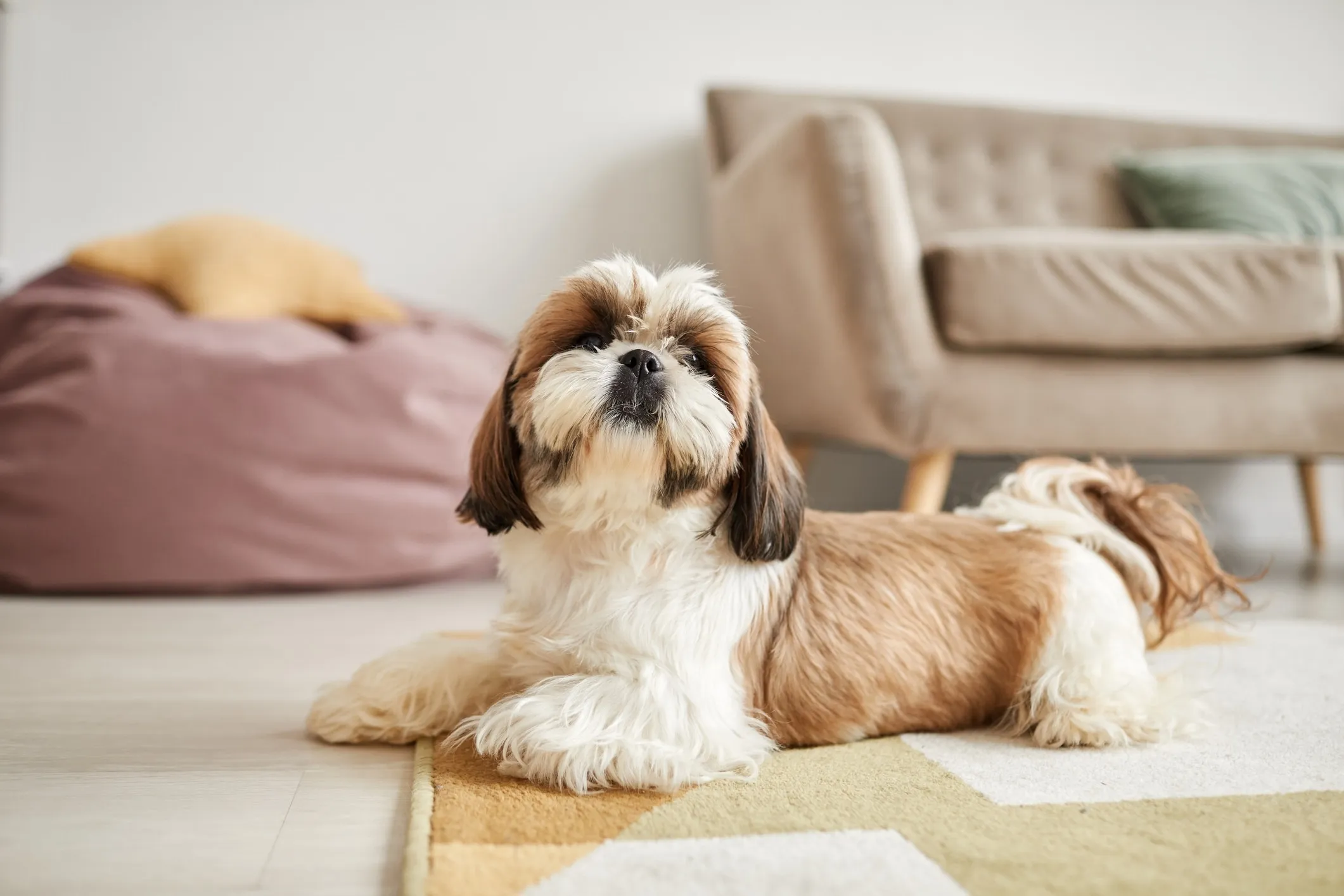 A brown and white Shih Tzu lying peacefully on a living room floor.
A brown and white Shih Tzu lying peacefully on a living room floor.
An ancient companion breed from Tibet, the Shih Tzu is adored for its friendly and outgoing temperament and luxurious double coat that, despite its thickness, sheds minimally. Their hair continues to grow, so regular grooming is essential to keep it from matting. Shih Tzus are known for their distinctive flat faces, which can predispose them to certain health issues like breathing difficulties and overheating, especially in warm weather. Their eyes may also be prone to tear stains, which can be managed with regular cleaning.
4. Miniature Schnauzer
 A salt and pepper Miniature Schnauzer wearing a pink harness in a lush park.
A salt and pepper Miniature Schnauzer wearing a pink harness in a lush park.
The Miniature Schnauzer is a robust and spirited small dog with a wiry, low-shedding double coat. They are intelligent, alert, and can fit into many different home environments due to their compact size. Despite their small stature, they are energetic and require at least an hour of daily exercise to stay happy and well-behaved. Their distinctive facial hair (beard and eyebrows) and body coat need regular hand-stripping or clipping to maintain its texture and minimize shedding.
5. Standard Schnauzer
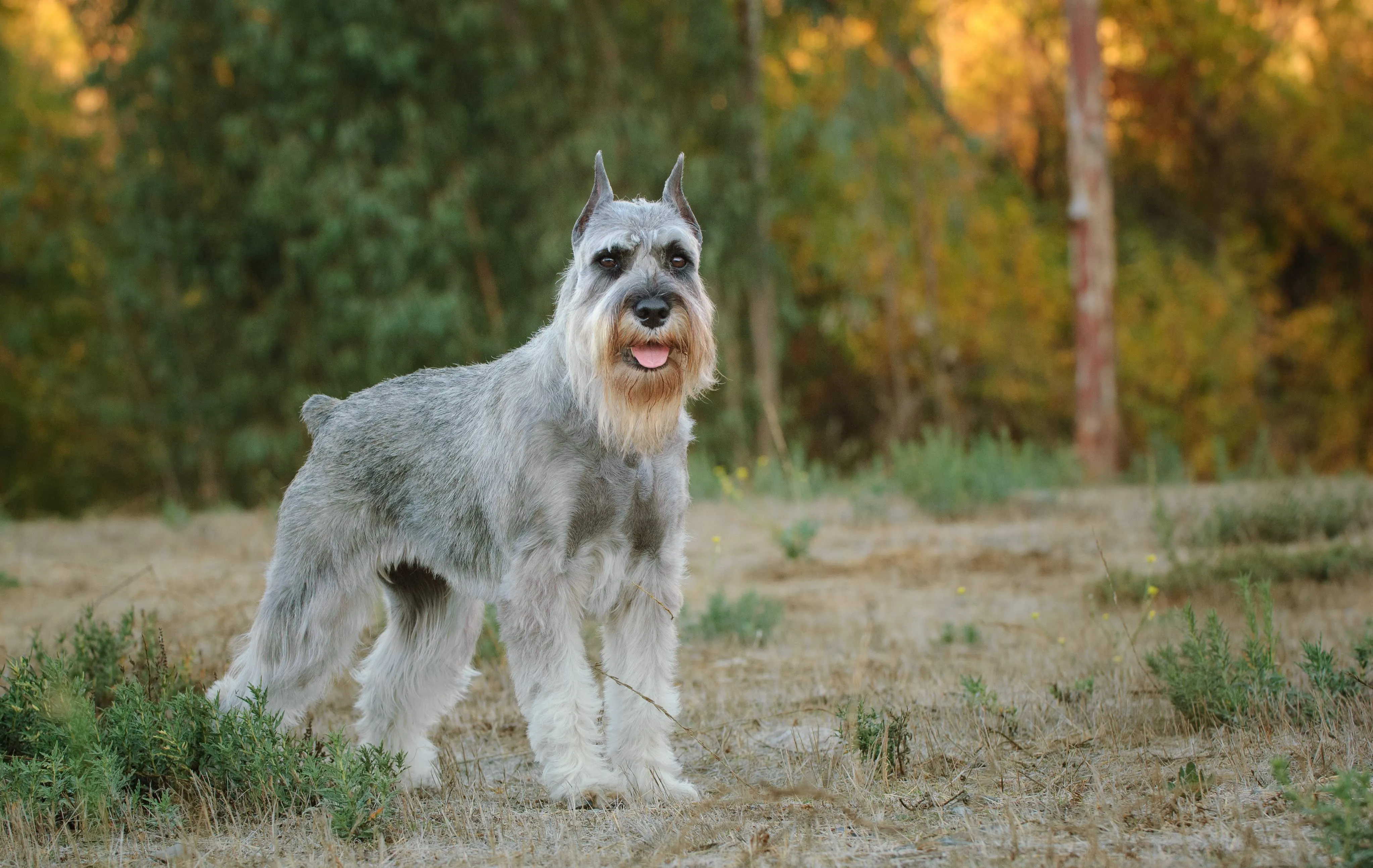 A gray Standard Schnauzer standing alertly in a green field.
A gray Standard Schnauzer standing alertly in a green field.
The Standard Schnauzer shares many admirable traits with its miniature counterpart but in a larger, more powerful build, typically weighing up to 45 pounds. They also boast a dense, wiry coat that sheds very little. These intelligent and active dogs thrive on long walks, engaging games of fetch, and problem-solving with puzzle toys. Like all Schnauzers, their coats benefit from regular grooming, including brushing and occasional hand-stripping or clipping to keep it in top condition and ensure their low-shedding qualities remain optimal.
6. Giant Schnauzer
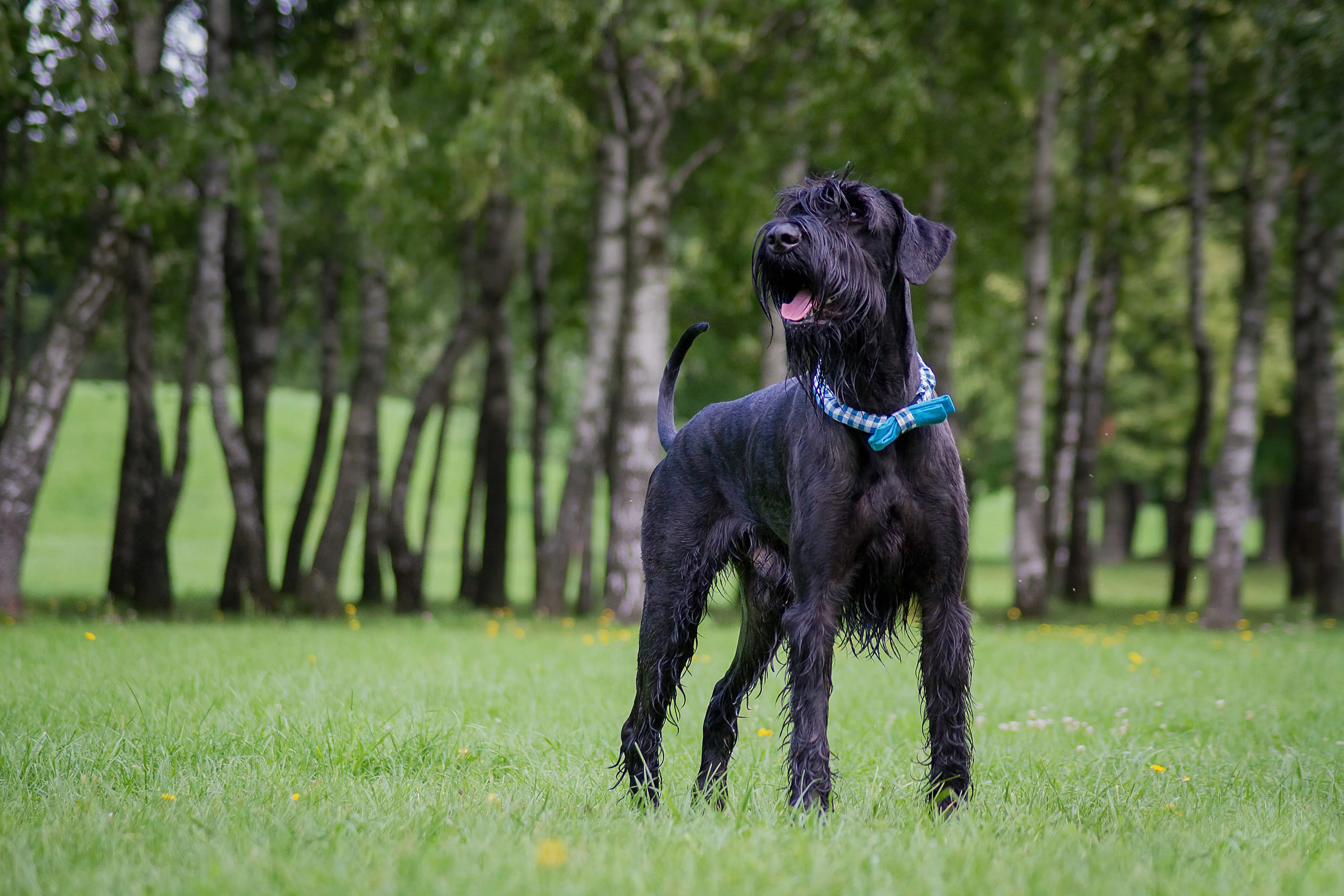 A majestic black Giant Schnauzer with a blue bow collar, wet from water, standing in a park.
A majestic black Giant Schnauzer with a blue bow collar, wet from water, standing in a park.
The largest of the Schnauzer family, Giant Schnauzers can weigh up to 85 pounds and stand over 27 inches tall. They possess a dense, wiry, low-shedding coat similar to the other Schnauzer varieties. These powerful and intelligent dogs require substantial daily exercise, such as long walks, vigorous runs, and challenging hikes, to channel their energy positively. Their impressive size and energy levels make them suited for experienced owners who can provide consistent training and activity.
7. Bichon Frise
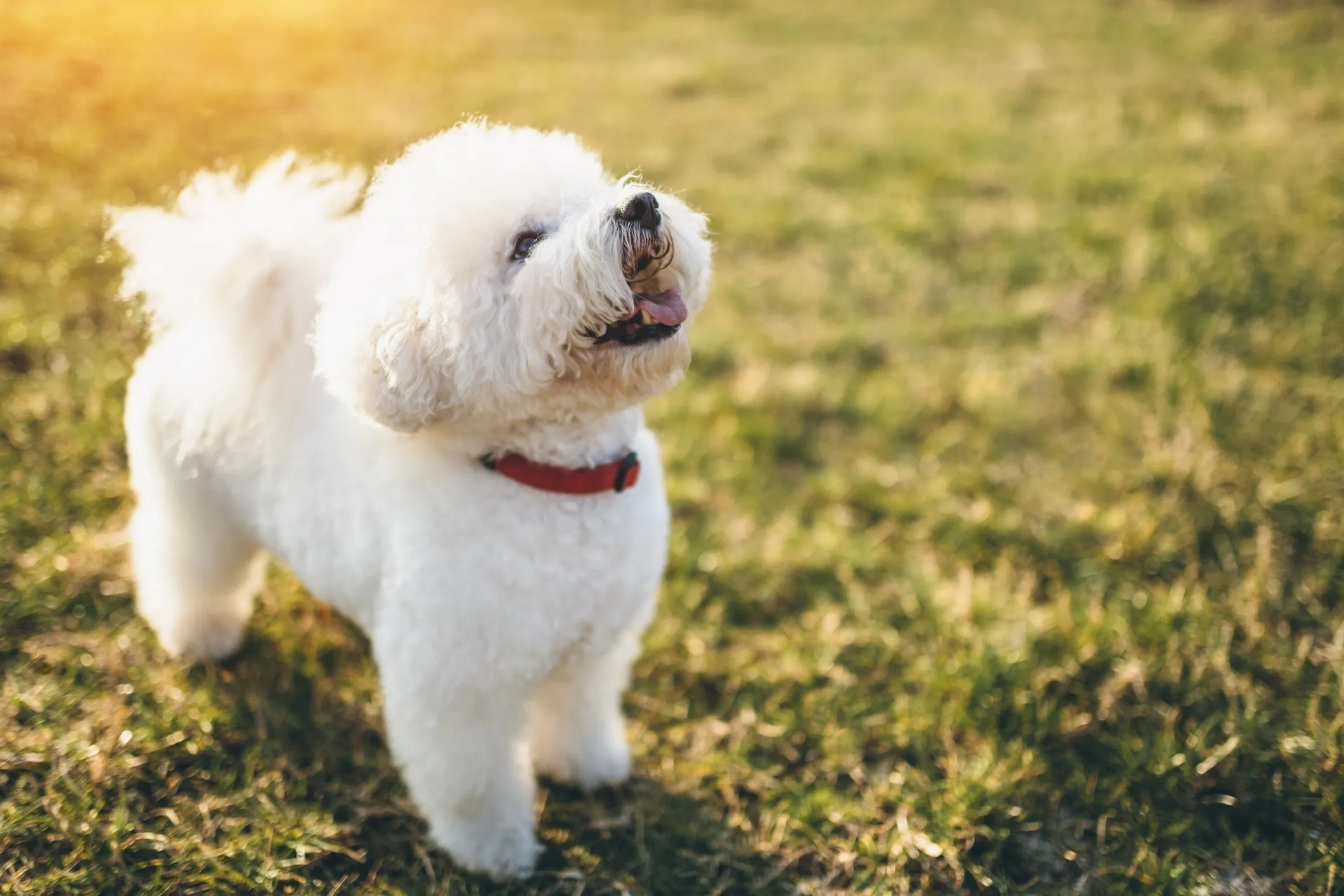 A fluffy white Bichon Frise looking upwards while sitting in green grass.
A fluffy white Bichon Frise looking upwards while sitting in green grass.
Small, cheerful, and full of charm, the Bichon Frise is a playful pup with a curly, cotton-ball-like coat that sheds very little. Their hypoallergenic coat, however, needs diligent grooming with daily brushing to prevent mats and regular professional trims. Highly intelligent and eager to please, Bichons are easily trainable using positive reinforcement and excel at learning tricks, making them delightful family companions.
8. Chinese Crested
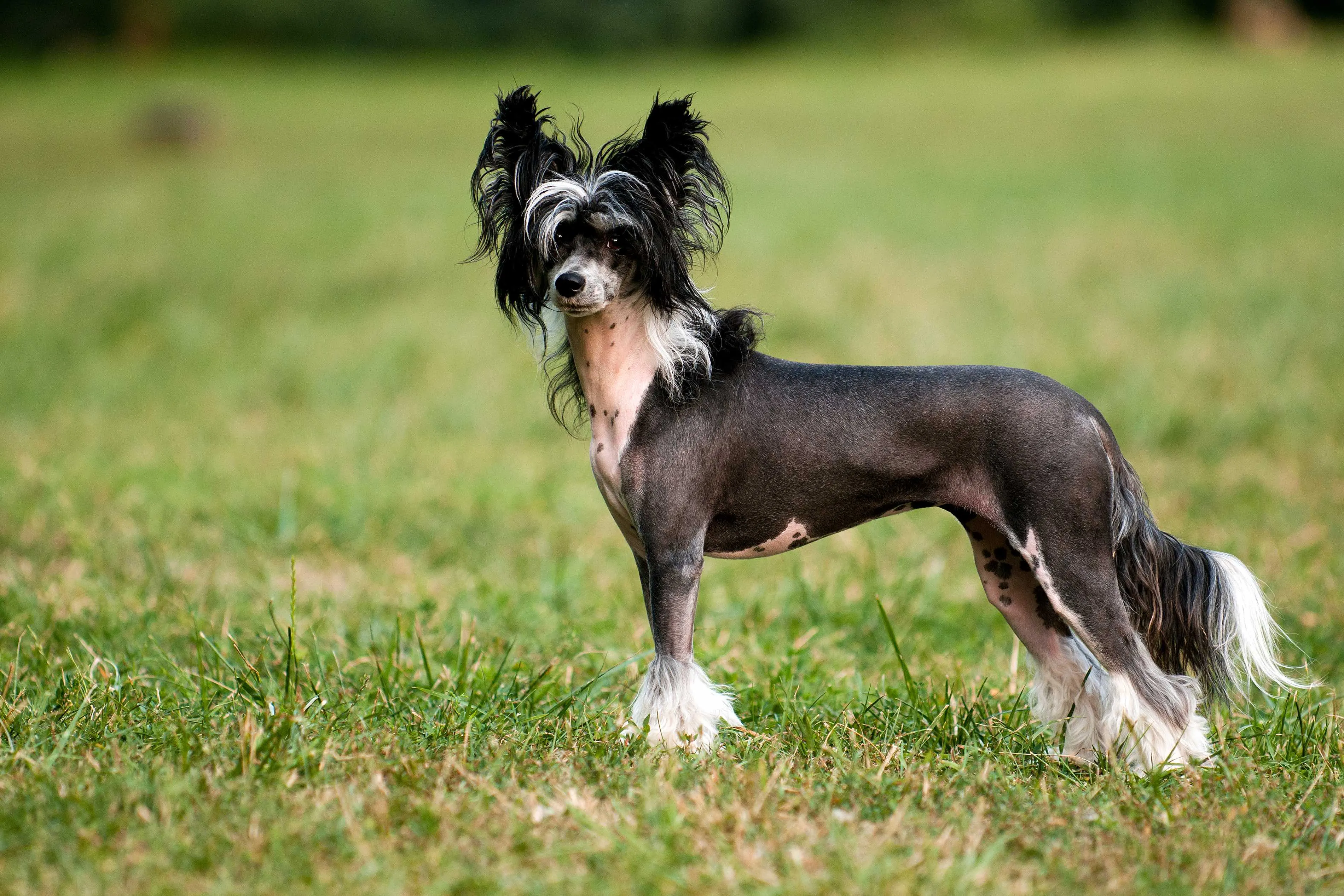 A black hairless Chinese Crested dog looking directly at the camera.
A black hairless Chinese Crested dog looking directly at the camera.
The Chinese Crested is a unique “small breed” known for its distinctive appearance. This breed comes in two varieties: the Hairless, with smooth skin and tufts of hair on the head, tail, and paws, and the Powderpuff, covered in a full, soft coat. Both varieties are considered low-shedding, with the Hairless being virtually shed-free. They are playful, affectionate, and make wonderful, devoted companions. The Hairless variety requires skin care to prevent sunburn and dryness.
9. Portuguese Water Dog
 A black and white Portuguese Water Dog wearing a red maple leaf bandana, standing near water.
A black and white Portuguese Water Dog wearing a red maple leaf bandana, standing near water.
Originally bred to assist fishermen, the Portuguese Water Dog is a medium-sized dog that doesn’t shed much thanks to its thick, curly, single coat. These dogs are highly intelligent, easily trainable, and possess a friendly disposition, making them excellent family pets. They are high-energy pups that thrive on regular exercise, especially activities involving water, such as swimming and retrieving floating toys. Their coats require frequent brushing and clipping to remain healthy and free of mats.
10. Labradoodle
 A brown Standard Labradoodle walking through a park on a sunny day.
A brown Standard Labradoodle walking through a park on a sunny day.
A crossbreed between a Labrador Retriever and a Poodle, the Labradoodle was initially bred as a hypoallergenic service dog. While shedding levels can vary depending on the specific Poodle genetics inherited, many Labradoodles have a low-shedding coat. They are intelligent, friendly, and known for being excellent family pets. Their gentle nature and high trainability make them a joy to live with, especially when well-exercised and socialized from a young age. Regular grooming is essential for their wavy or curly coats.
11. Goldendoodle
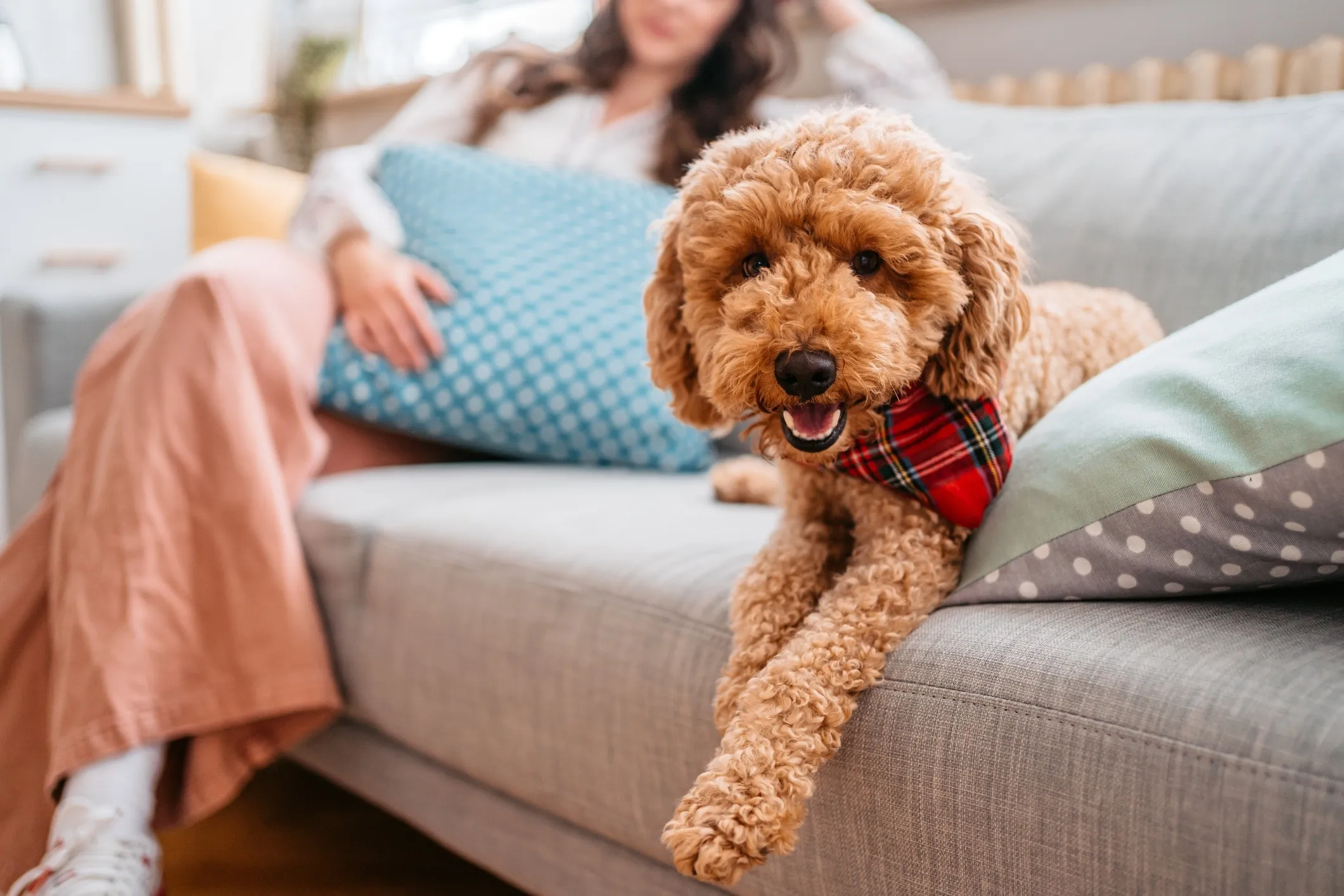 A Goldendoodle lying comfortably on a couch with a person sitting in the background.
A Goldendoodle lying comfortably on a couch with a person sitting in the background.
Another popular “doodle” breed, the Goldendoodle is a mix of a Golden Retriever and a Poodle. Similar to Labradoodles, they are highly intelligent and possess a friendly, affectionate nature. Their coats are typically low-shedding, though the extent can vary. While many are known for their golden hues, they come in a range of colors and coat textures. Frequent grooming with a slicker brush is necessary to prevent matting and keep their soft coats in good condition.
12. Lagotto Romagnolo
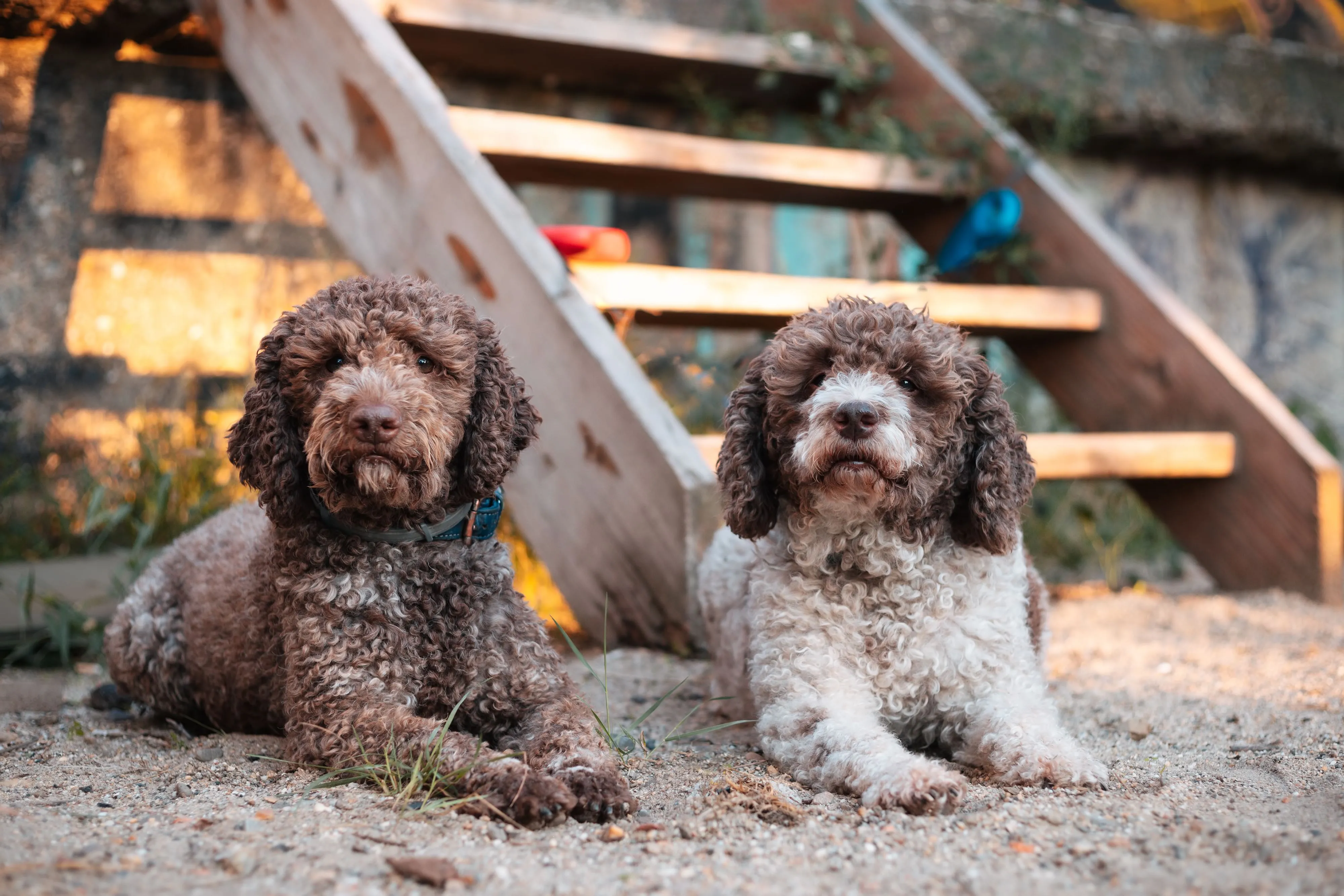 Two Lagotto Romagnolo dogs lying in the dirt, staring at the camera.
Two Lagotto Romagnolo dogs lying in the dirt, staring at the camera.
These charming dogs were originally bred as water retrievers, and their curly, woolly, low-shedding coats protected them from chilly waters. While less common, Lagotti Romagnoli (the plural form) are known for being good with children and other pets, making them excellent family dogs. Their unique coats require specific grooming, including regular trimming and brushing to prevent matting, especially after water activities.
13. Affenpinscher
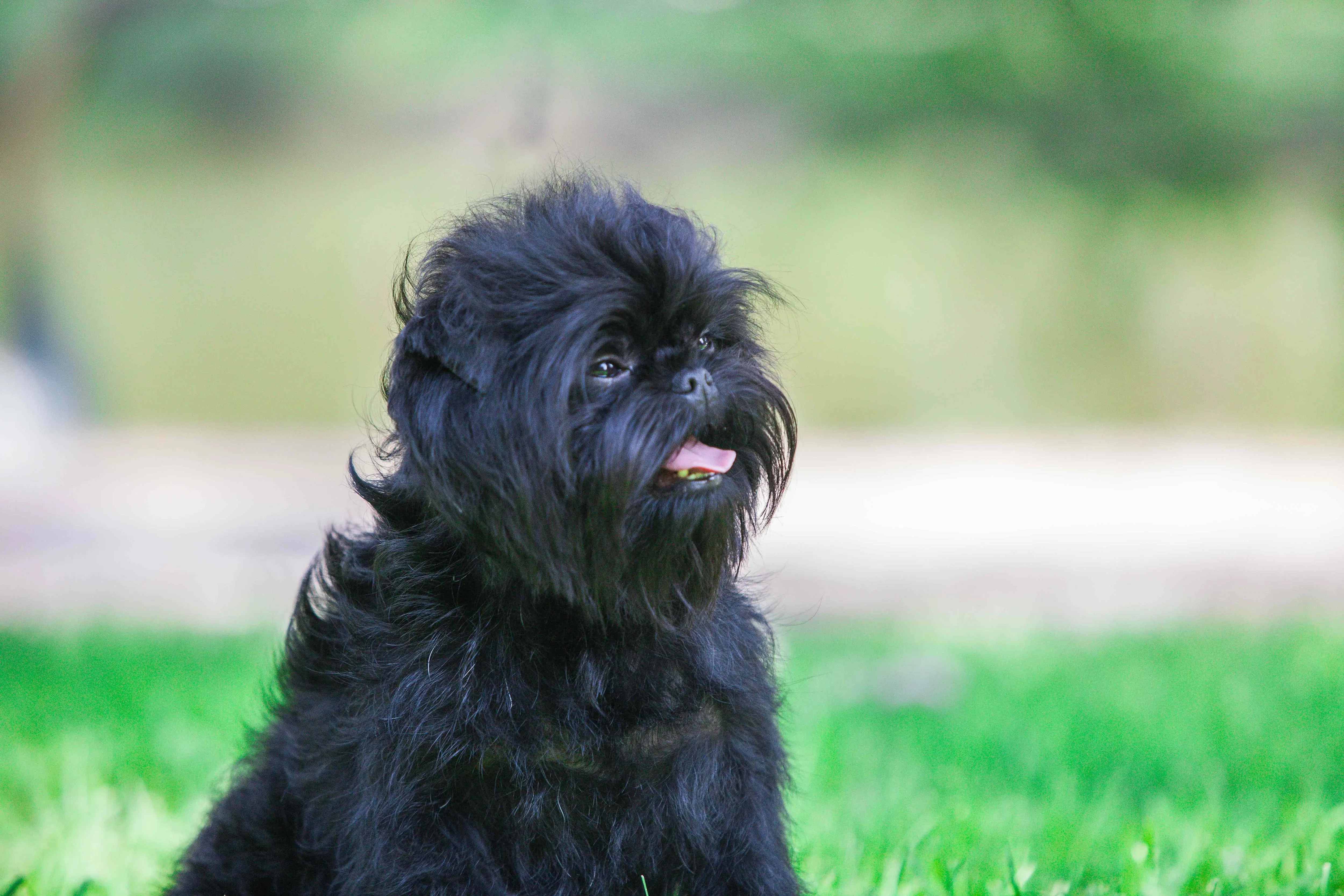 A close-up of a black Affenpinscher dog's face, showing its monkey-like appearance.
A close-up of a black Affenpinscher dog's face, showing its monkey-like appearance.
Affenpinschers are small, spirited dogs known for their distinctive monkey-like appearance. Their dense, wiry coat produces fewer allergens and sheds minimally compared to many other breeds. However, this unique coat requires dedicated care, including regular at-home brushing and occasional hand-stripping, a traditional grooming method where dead hair is plucked from the root rather than trimmed, to maintain its texture and low-shedding quality.
14. Irish Water Spaniel
 A profile view of a brown Irish Water Spaniel with a distinct topknot.
A profile view of a brown Irish Water Spaniel with a distinct topknot.
Friendly, intelligent, and highly trainable, the Irish Water Spaniel is another water-loving breed with a thick, curly, low-shedding coat. Their coat is always liver (brown) in color and requires regular grooming to prevent tangles and mats. These active dogs have a high energy level, making daily exercise essential for their physical and mental well-being. Their strong retrieving instincts and love for water make them excellent companions for active families.
15. Aussiedoodle
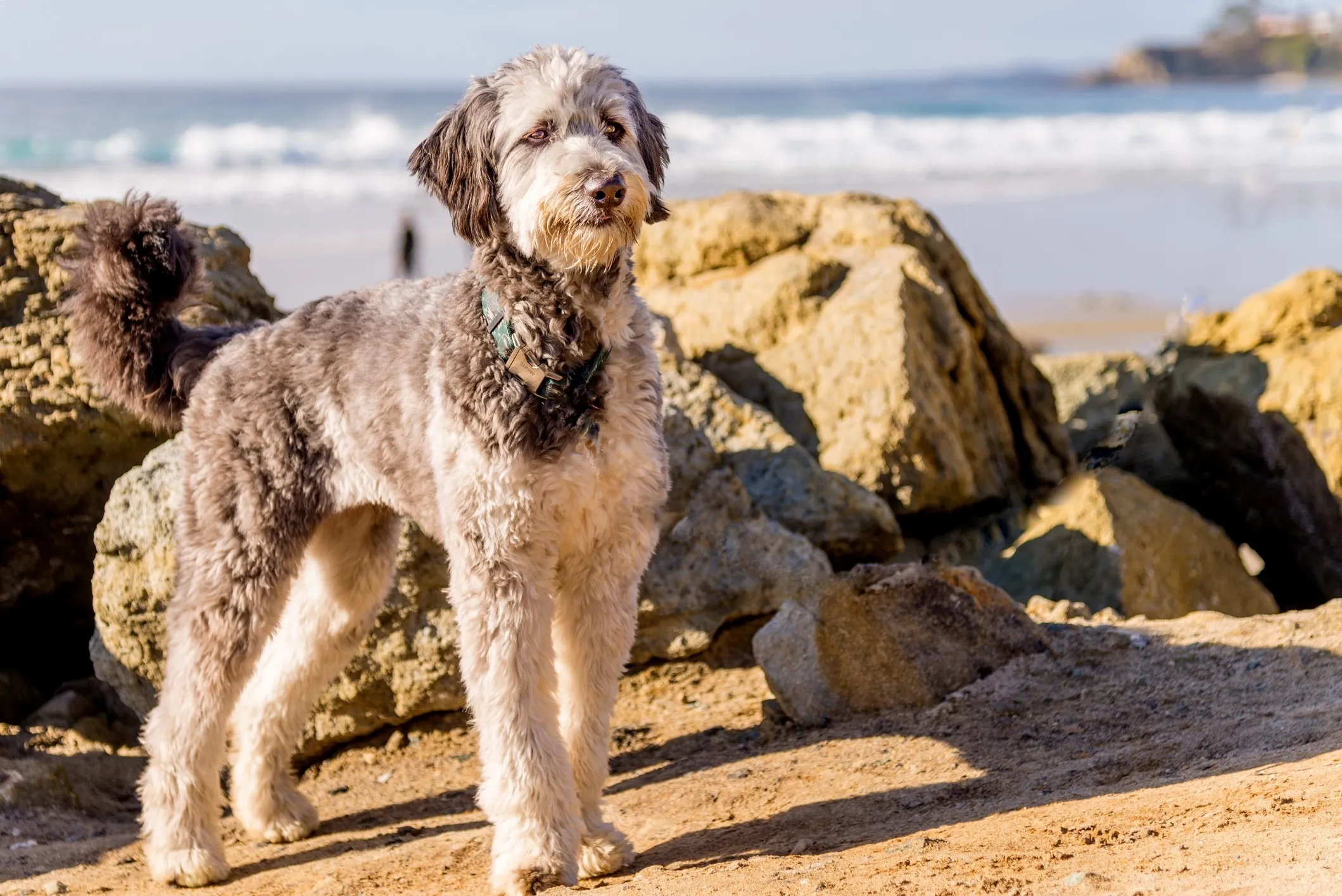 A standard Aussiedoodle dog standing proudly on a sandy beach.
A standard Aussiedoodle dog standing proudly on a sandy beach.
The Aussiedoodle is a cross between an Australian Shepherd and a Standard or Miniature Poodle. These smart medium sized dogs that don’t shed are highly intelligent and exceptionally energetic, inheriting traits from both parent breeds. Their coats are typically low-shedding, though consistency can vary. Aussiedoodles require significant exercise and mental stimulation to prevent boredom and potential destructive behaviors. Enrichment toys and engaging activities are crucial for their happiness.
16. Bolognese
 A white Bolognese dog sitting gracefully in an autumn forest.
A white Bolognese dog sitting gracefully in an autumn forest.
Originating in Italy, Bolognese dogs are cute, fluffy companions with a long, characteristically messy, yet low-shedding white coat. Despite their dishevelled appearance, their coats require frequent grooming to prevent matting. These playful and easygoing pups are known for getting along well with children and other pets, adapting readily to various living situations, making them ideal family dogs.
17. Maltese
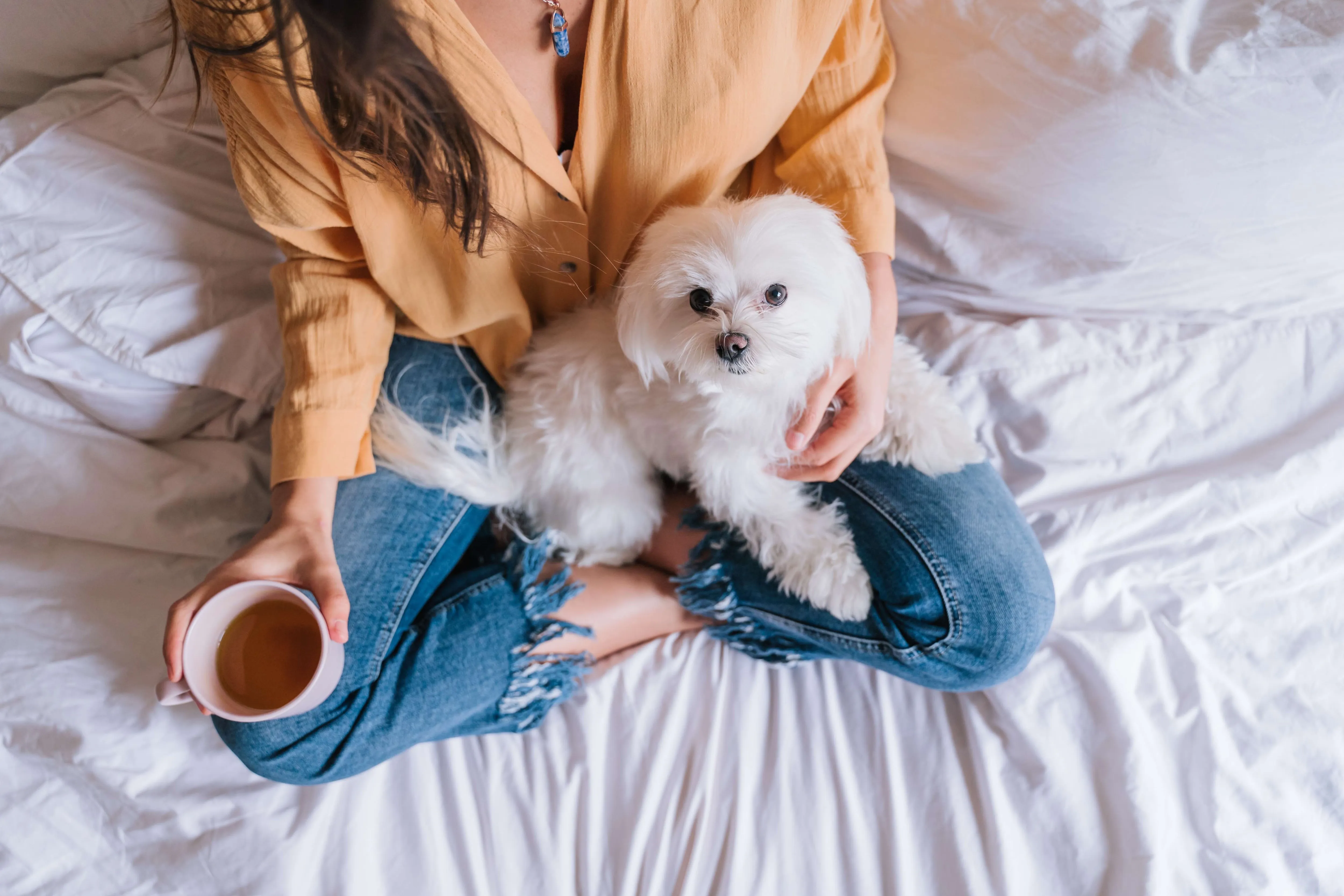 A woman gently holding a fluffy white Maltese dog on a bed.
A woman gently holding a fluffy white Maltese dog on a bed.
The Maltese is a delightful small dog renowned for its luxurious, silky white coat that resembles human hair and sheds minimally. They make affectionate and playful companions, but prospective owners must be prepared for their significant grooming needs. To manage their long coat, daily brushing is essential, and many owners opt for a shorter “puppy cut” to simplify maintenance. Without proper grooming, their fine hair can quickly tangle and mat.
18. Soft Coated Wheaten Terrier
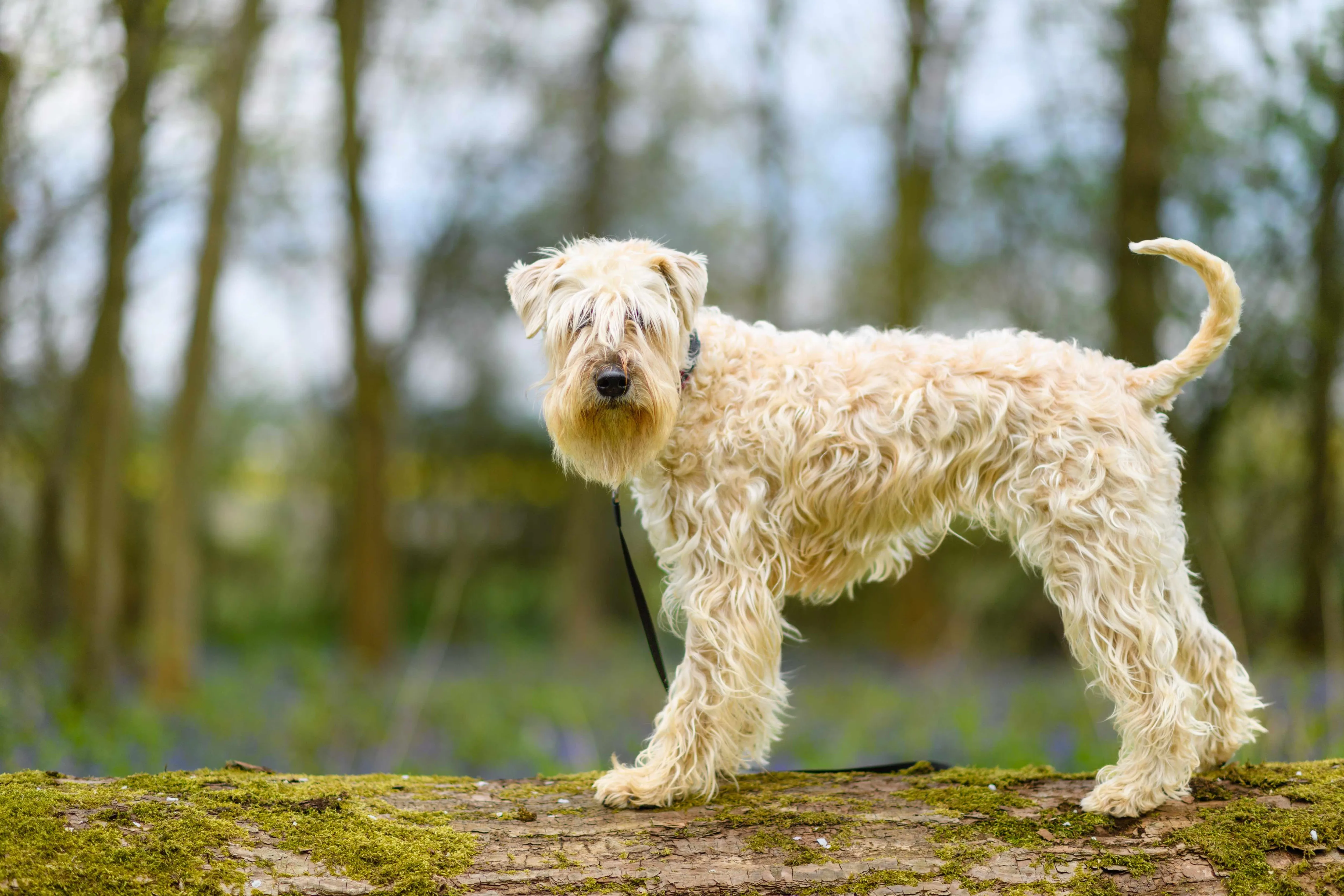 A Soft Coated Wheaten Terrier dog sitting on a log amidst foliage.
A Soft Coated Wheaten Terrier dog sitting on a log amidst foliage.
This medium-sized Irish breed is famed for its incredibly soft, silky coat that, as the name suggests, has a wheaten color and sheds very little. Wheatens maintain a high energy level throughout their lives, typical of terriers, and require ample exercise and mental stimulation to be well-behaved and content. Their beautiful coats demand regular brushing and professional grooming to prevent matting and keep them looking their best.
19. Coton de Tulear
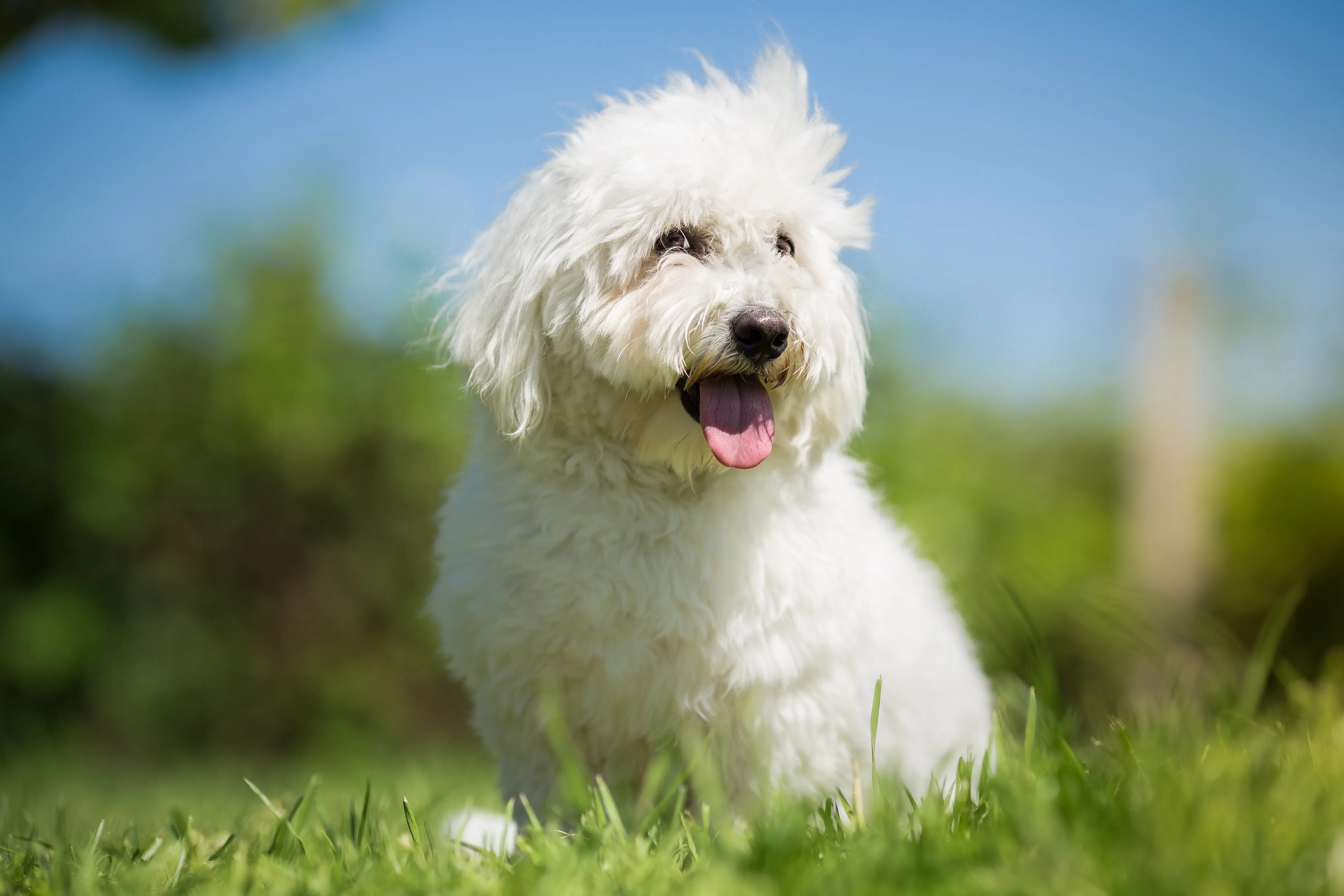 A white Coton de Tulear sitting in green grass with its hair gently blowing in the wind.
A white Coton de Tulear sitting in green grass with its hair gently blowing in the wind.
A small, charming breed originating from Madagascar, Cotons de Tulear are easygoing dogs with a soft, cotton-like coat that is low-shedding. Their amiable nature makes them an excellent fit for families with children and other pets, especially when introductions are handled properly. Cotons are adaptable and thrive on companionship, enjoying both relaxed indoor time and playful outdoor activities. Their unique coat requires consistent grooming to avoid tangles.
20. Schnoodle
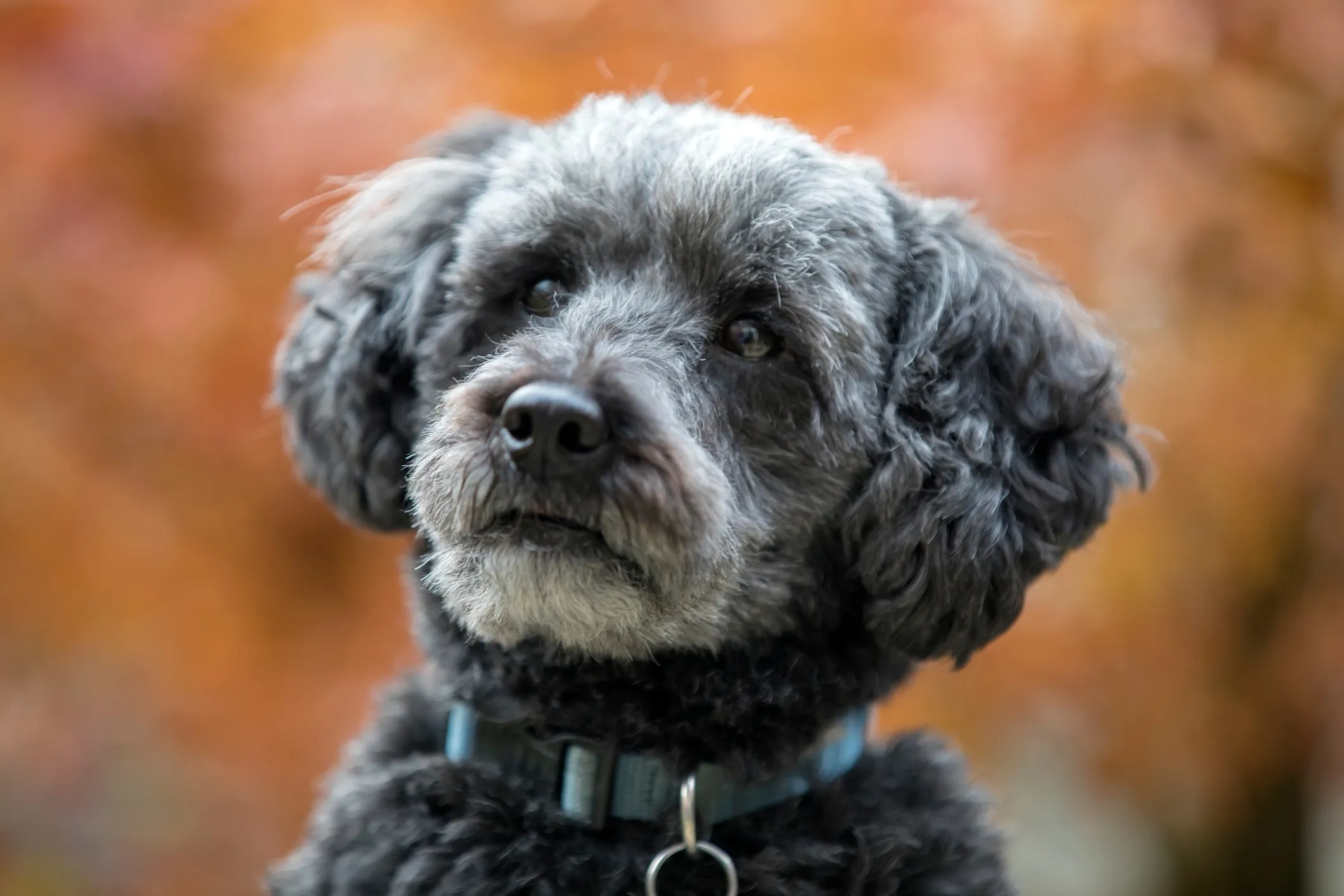 A close-up of a gray Schnoodle dog with a curly coat.
A close-up of a gray Schnoodle dog with a curly coat.
Unlike many “doodle” breeds that mix a Poodle with a shedding dog, the Schnoodle combines two low-shedding breeds: the Schnauzer and the Poodle. This makes them an excellent choice for allergy sufferers. Their coat can be curly or wavy, depending on their genetic inheritance, but it is consistently low-shedding. Schnoodles are known for their intelligence, playful nature, and adaptability, making them wonderful family additions that generally require moderate exercise and regular grooming.
21. Bedlington Terrier
 A white Bedlington Terrier running playfully through snow.
A white Bedlington Terrier running playfully through snow.
Often described as “a lamb in dog’s clothing,” the Bedlington Terrier is a distinctive curly-haired breed known for its unique topknot and pom-pom ear tufts. Their woolly, low-shedding coat requires regular grooming, including clipping, to maintain its characteristic appearance. Bedlingtons are deeply devoted to their families and can develop separation anxiety if left alone for extended periods. They are energetic and require regular exercise to stay happy and healthy.
22. Xoloitzcuintli
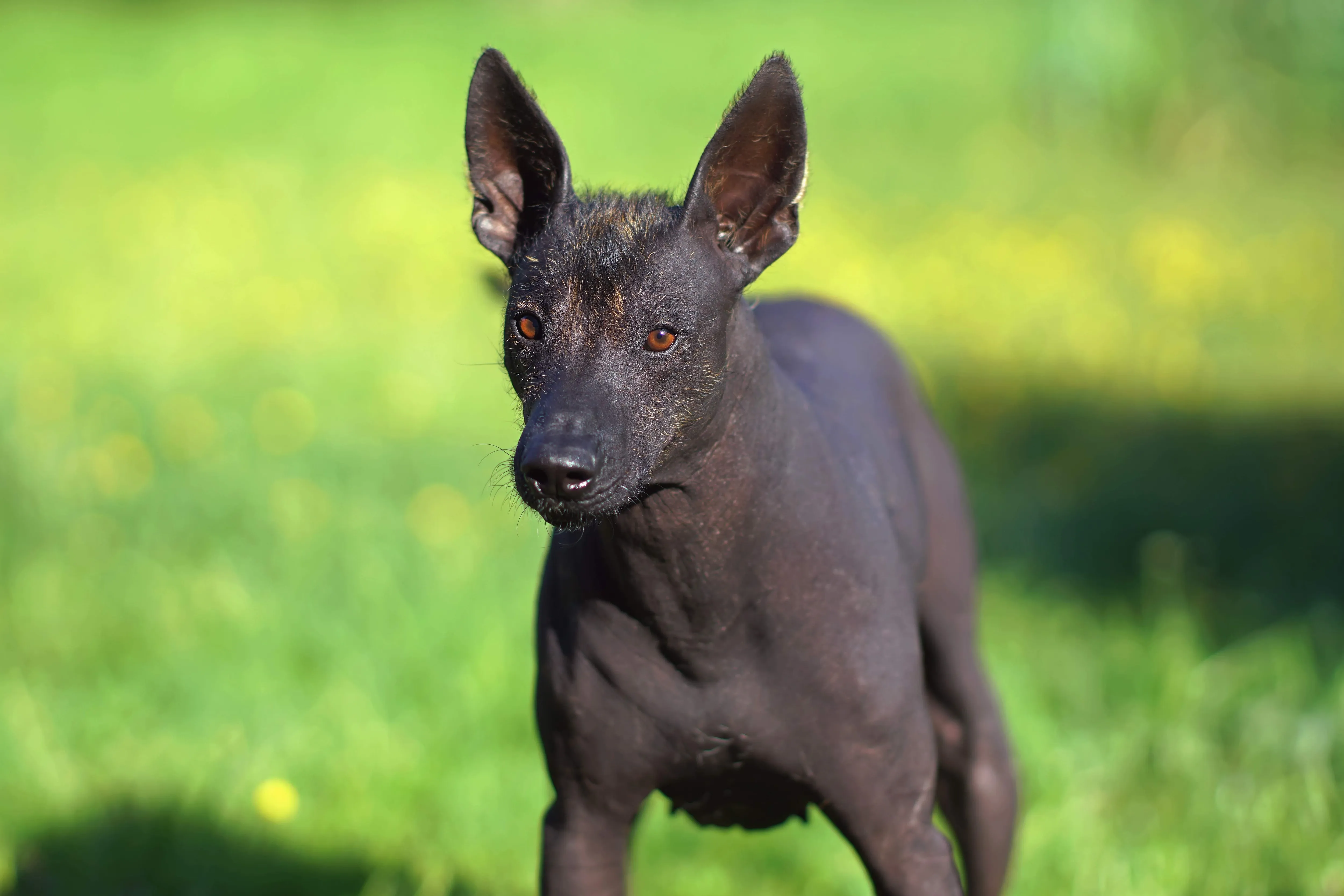 A sleek black Mexican Hairless Dog (Xoloitzcuintli) standing attentively in green grass.
A sleek black Mexican Hairless Dog (Xoloitzcuintli) standing attentively in green grass.
Also known as the Mexican Hairless Dog, the Xoloitzcuintli (pronounced Sho-lo-eets-kweent-lee) is one of the oldest and rarest dog breeds. They come in three sizes (toy, miniature, and standard) and can be hairless or covered in a very short, fine coat. Both varieties are low-shedding, with the hairless version being an ideal choice for severe allergy sufferers. Their hairless skin requires protection from sun and cold, while the coated variety needs minimal grooming. Xolos are known for their calm, loyal, and watchful nature.
23. Whoodle
 A tan Whoodle puppy playfully dragging a washcloth.
A tan Whoodle puppy playfully dragging a washcloth.
The Whoodle is a delightful cross between a Soft-Coated Wheaten Terrier and a Poodle. These friendly dogs are prized for their very low-shedding coats, inheriting the best qualities from both parent breeds, including intelligence and an affectionate nature. Whoodles are adaptable and enjoy being part of family activities. Their soft, wavy, or curly coats require regular brushing and grooming to prevent tangles and maintain their appealing appearance.
24. Bernedoodle
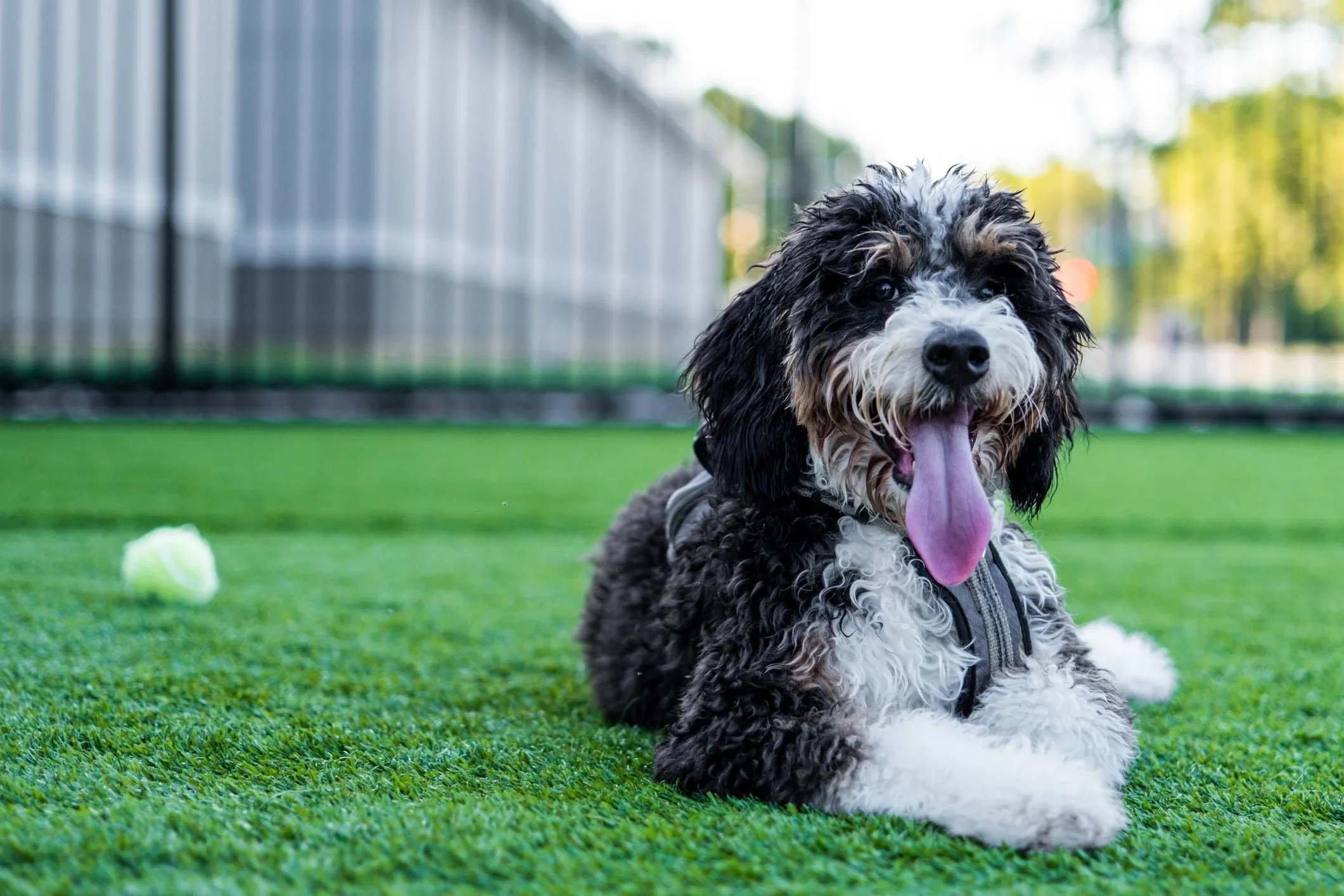 A large Bernedoodle dog lying contentedly in green grass with its tongue playfully out.
A large Bernedoodle dog lying contentedly in green grass with its tongue playfully out.
A crossbreed between a Bernese Mountain Dog and a Poodle, Bernedoodles are known for their friendly, affectionate nature and gentle demeanor. These large, low-shedding dogs are a popular choice for families with children and other pets. While shedding can vary, many Bernedoodles inherit the Poodle’s low-shedding coat. They are active dogs that require plenty of exercise and mental stimulation to thrive.
25. Shorkie
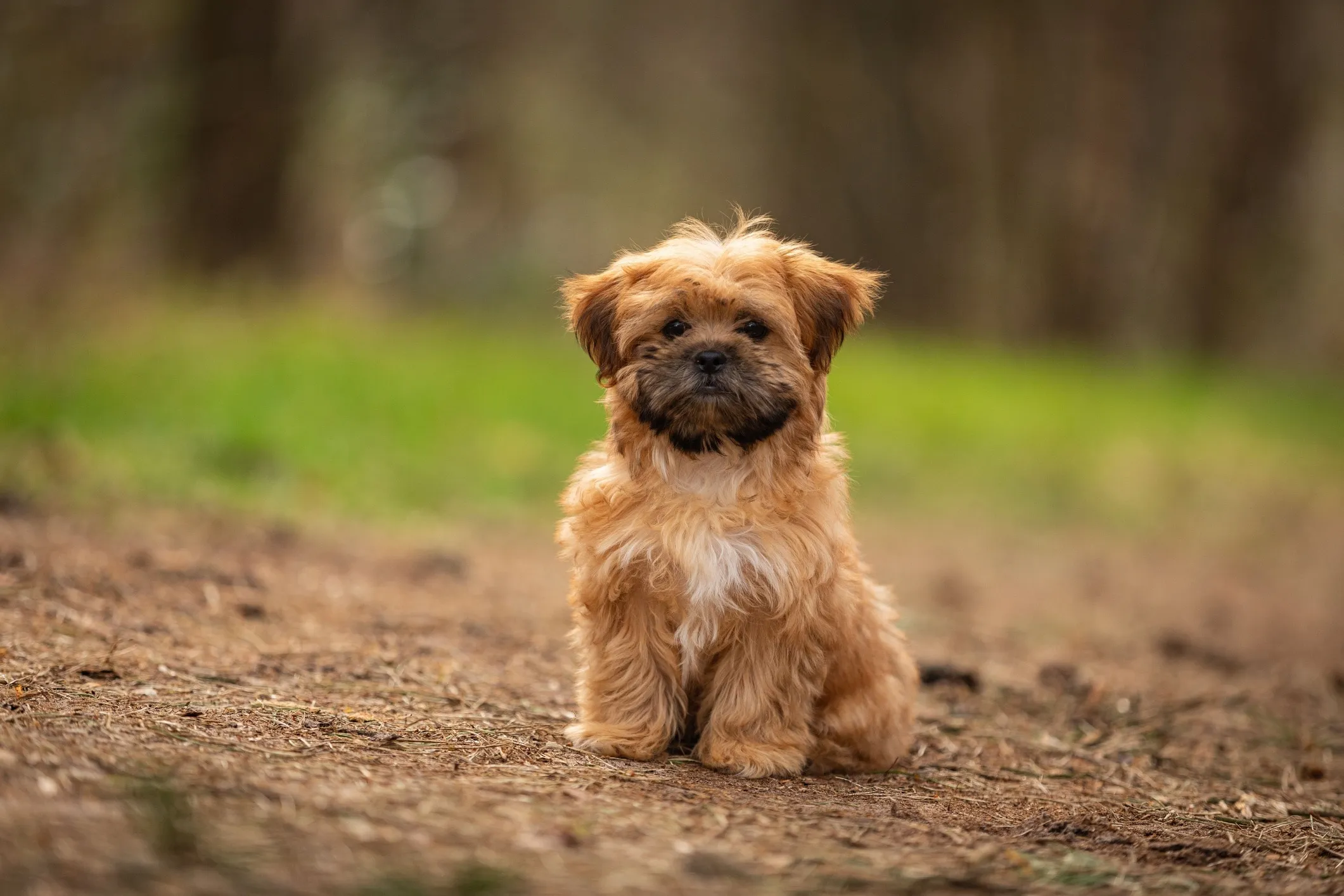 A tri-color Shih Tzu and Yorkie mix (Shorkie) sitting on a hiking trail.
A tri-color Shih Tzu and Yorkie mix (Shorkie) sitting on a hiking trail.
The Shorkie is a mixed breed combining two already low-shedding dogs: the Shih Tzu and the Yorkshire Terrier. This results in a small, playful, and friendly companion that sheds minimally. Shorkies are best described as the “best of both breeds,” offering an affectionate and spirited personality. Like most dogs with continually growing hair, they require a regular grooming routine, including daily brushing, to prevent mats and keep their coats healthy.
26. Afghan Hound
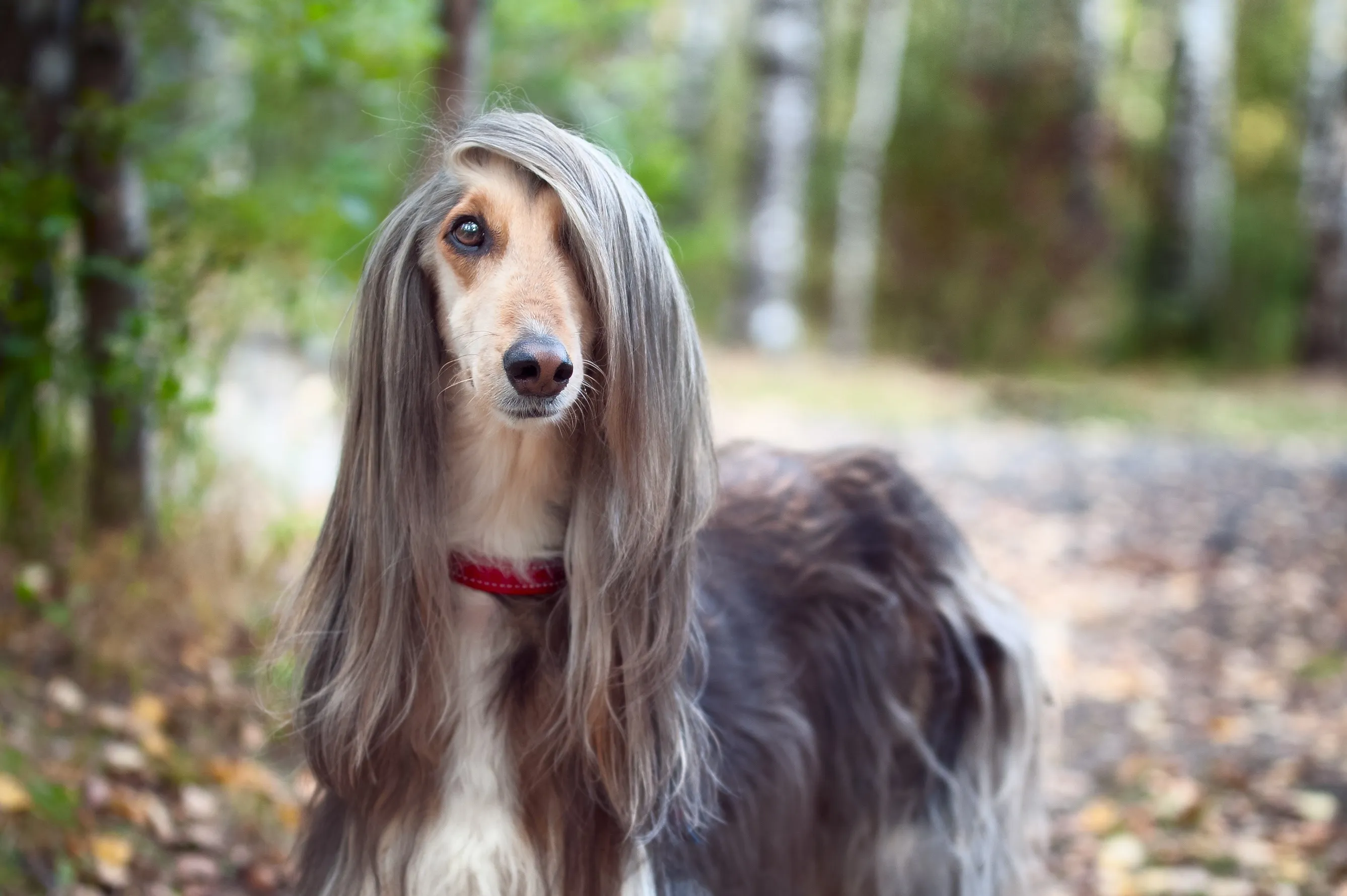 A striking gray and tan Afghan Hound looking thoughtfully at the camera.
A striking gray and tan Afghan Hound looking thoughtfully at the camera.
Afghan Hounds are instantly recognizable by their elegant, long, flowing coats and slender, athletic builds. While their coat appears voluminous, they are considered low-shedding. These pups were built for running and are incredibly fast. Afghan Hounds are loving and devoted to their families but can be aloof with strangers, necessitating early and consistent socialization. Their magnificent coats require extensive grooming to prevent tangles and mats, including frequent brushing and bathing.
27. Barbet
 A close-up of a curly red Barbet dog's face, highlighting its characteristic beard.
A close-up of a curly red Barbet dog's face, highlighting its characteristic beard.
The Barbet, pronounced “bar-bay,” is a cheerful and devoted companion with a shaggy, woolly, low-shedding coat. The breed’s name is derived from the French word barbe, meaning beard, a nod to their hairy chin. These loving dog breeds that don’t shed enjoy water activities thanks to their protective curly coats. To maintain the Barbet’s coat in good condition, especially after swimming, regular brushing (two to three times a week) with a slicker or pin brush is essential.
28. Shih-Poo
 A close-up of a tan and black Shih-Poo dog's face.
A close-up of a tan and black Shih-Poo dog's face.
The Shih-Poo is a mixed breed resulting from a cross between a Shih Tzu and a Poodle (most commonly a Toy Poodle). This small, charming pup typically inherits a low-shedding coat and can thrive in almost any living situation. They require approximately 30 minutes of daily exercise and regular brushing sessions to keep their coats healthy and prevent matting. Shih-Poos are known for their affectionate and playful personalities.
29. Peruvian Inca Orchid
 A sleek Peruvian Inca Orchid dog standing outdoors.
A sleek Peruvian Inca Orchid dog standing outdoors.
Though quite rare, the Peruvian Inca Orchid is a fascinating breed that is naturally low-shedding thanks to its predominantly hairless body. As the national dog of Peru, this ancient breed comes in three sizes (small, medium, and large). While they are mostly hairless, they can have some hair on their head, tail, and feet. Like the Xoloitzcuintli, their skin needs protection from the elements. They are typically noble, alert, and affectionate dogs.
30. Malshi
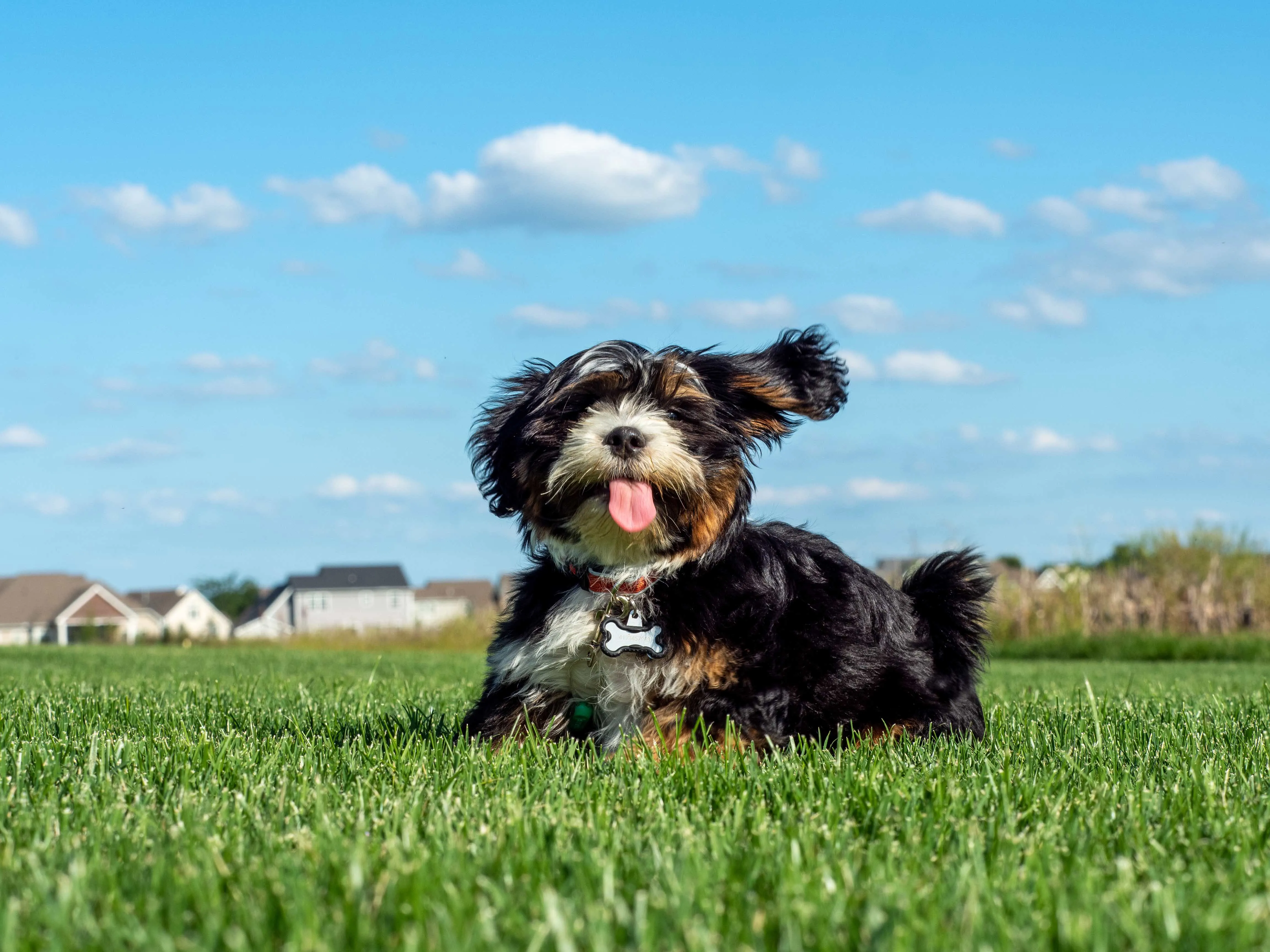 A tri-color Malshi dog sitting contentedly in lush green grass.
A tri-color Malshi dog sitting contentedly in lush green grass.
The Malshi, a cross between the Maltese and Shih Tzu, is a happy, small, and wonderfully low-shedding companion. These dogs thrive on close companionship and are happiest when their favorite humans are near. Their sweet and outgoing personalities make them ideal lapdogs and family members. As with most breeds on this list, a consistent grooming routine is crucial to keep their fluffy coats free of mats and tangles.
Living Happily with a Low-Shedding Dog: Essential Care Tips
Choosing a dog that doesn’t shed their fur is a great first step, but responsible ownership also involves specific care to maximize comfort for allergy sufferers and ensure your pup’s well-being.
Consistent Grooming is Key
Even low-shedding dogs require regular grooming because their coats continue to grow or trap dead hair. This often includes:
- Regular Brushing: Daily or every-other-day brushing is crucial for many low-shedding breeds to remove loose hairs trapped in their coats and prevent matting. Specific brush types, like slicker brushes or pin brushes, are often recommended for their coat types.
- Bathing: While not a solution for allergies on its own, regular bathing (typically every 4-6 weeks) can help remove dander and loose hair. Using a gentle, vet-recommended shampoo can also improve skin health and minimize irritants.
- Professional Grooming: Many low-shedding breeds, especially those with continuously growing hair like Poodles and their mixes, require professional clipping or hand-stripping every 4-8 weeks. Budgeting for this or learning to groom at home is an important consideration.
Maintaining a Clean Environment
Minimizing allergens in your home goes hand-in-hand with proper dog care:
- Frequent Cleaning: Vacuuming carpets and upholstery, dusting surfaces, and washing bedding (both yours and your dog’s) regularly can significantly reduce the accumulation of pet dander.
- Air Quality: Using high-efficiency particulate air (HEPA) filters in your vacuum cleaner and air purifiers can help remove airborne allergens. Ensuring good ventilation in your home also aids in keeping the air fresh.
- Designated Pet-Free Zones: Designating certain areas, like bedrooms, as pet-free zones can provide a sanctuary for allergy sufferers and help reduce allergen exposure, especially during sleep.
Consulting Your Healthcare Provider
If you or a family member has dog allergies, it’s always wise to consult with a healthcare provider or allergist. They can help you develop a comprehensive allergy management plan, which may include:
- Medication: Over-the-counter or prescription antihistamines, nasal sprays, and eye drops can alleviate symptoms.
- Immunotherapy (Allergy Shots): For some, a series of allergy shots can significantly reduce sensitivity over time.
- Awareness of Triggers: Understanding that allergens are in dander, saliva, and urine means avoiding close contact with your dog’s face or allowing them to lick you, especially if you’re sensitive. Washing hands after petting is also helpful.
Bringing home a dog that doesn’t shed their fur can profoundly enhance the quality of life for individuals with allergies, offering the immense joy and companionship of a pet without the constant discomfort. By understanding the nature of low-shedding breeds and committing to proper grooming and home maintenance, you can create a harmonious and sniffle-free environment for both you and your beloved canine companion.
